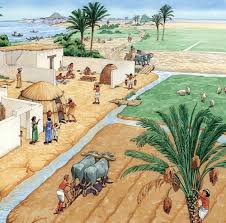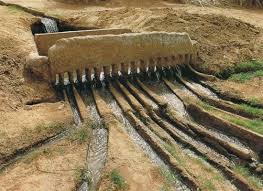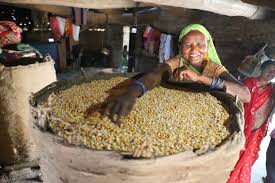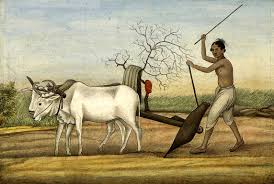Ancient agricultural practices form the foundation of modern civilization, providing the sustenance necessary for communities to thrive and evolve.
As humanity transitioned from nomadic lifestyles to settled societies, these early techniques became crucial in securing food supplies, influencing social structures, economies, and cultures.
From the fertile banks of the Nile in Egypt to the vast plains of Mesopotamia, diverse methods developed to adapt to varying climates and landscapes.
Ancient farmers relied on innovative approaches such as irrigation, crop rotation, and selective breeding to enhance productivity and sustainability. These practices were often influenced by the natural environment, as communities learned to work with the land rather than against it.
The development of irrigation systems in ancient Egypt, for instance, enabled farmers to harness the annual flooding of the Nile, transforming arid land into fertile fields. Similarly, the cultivation of staple crops like wheat, rice, and maize laid the foundation for food security and population growth.
The techniques adopted by these early agricultural societies not only shaped their economies but also fostered trade, cultural exchange, and technological advancements. Additionally, agricultural practices played a significant role in establishing social hierarchies, as the control of food production often led to the rise of powerful leaders and organized states.
This exploration of ancient agricultural practices uncovers the ingenuity and resilience of early civilizations. By understanding these techniques, we gain insight into how they laid the groundwork for modern agriculture and the enduring impact they have on contemporary farming practices.
Through this journey into the past, we recognize the vital role agriculture has played in shaping human history and the ongoing quest for innovation in food production.
Domestication of Plants and Animals

The domestication of plants and animals marked a significant turning point in human history. Here are the key aspects of this process:
1. Transition from Hunting-Gathering: Early humans transitioned from a nomadic lifestyle to settled farming communities, leading to more stable food sources.
2. Selective Breeding: Farmers began to select and breed plants and animals with desirable traits, such as larger fruits or docile behavior, improving food production.
3. Major Crops Domesticated: Key crops like wheat, rice, maize, and barley were domesticated, forming the basis of diets in various regions.
4. Animal Domestication: Animals such as cattle, sheep, goats, and pigs were domesticated for meat, milk, and labor, providing additional food and resources.
5. Impact on Society: The domestication of plants and animals allowed for population growth, as more reliable food sources supported larger communities.
Traditional Farming Techniques and Tools
Traditional farming techniques and tools were essential for early agricultural societies. Here’s how they contributed to farming practices:
1. Hand Tools: Farmers used simple tools like hoes, sickles, and wooden plows to prepare the soil and harvest crops.
2. Fertility Management: Traditional techniques included composting and crop residues to enrich the soil and enhance fertility.
3. Irrigation Methods: Early civilizations developed irrigation systems, such as canals and ditches, to divert water from rivers to their fields.
4. Companion Planting: Farmers learned to plant certain crops together to enhance growth and deter pests, improving yields without chemicals.
5. Knowledge Sharing: Farming techniques were passed down through generations, with communities sharing knowledge on planting times, pest control, and crop management.
Crop Rotation and Its Importance
Crop rotation is a key agricultural practice that has significant benefits for soil health and productivity. Here’s why it is important:
1. Nutrient Management: Different crops require different nutrients from the soil. Rotating crops helps restore soil fertility and prevent nutrient depletion.
2. Pest Control: Rotating crops disrupts pest life cycles, reducing the buildup of pests and diseases that can harm specific crops.
3. Soil Structure Improvement: Different root structures from various crops improve soil structure and promote aeration, helping water infiltration.
4. Weed Management: Crop rotation can reduce weed populations by alternating between crops that compete differently with weeds.
5. Increased Yields: Overall, crop rotation can lead to higher and more sustainable yields, enhancing food security for growing populations.
Read Also: Are Honey Bees Endangered?
Irrigation Systems of Ancient Societies

Irrigation was crucial for agricultural success in ancient civilizations, especially in arid regions. Here are some key features of ancient irrigation systems:
1. Canals and Ditches: Ancient societies dug canals and ditches to divert water from rivers to their fields, ensuring a reliable water supply for crops.
2. Floodplain Farming: Farmers in river valleys used seasonal floods to irrigate their fields, taking advantage of the nutrient-rich silt deposited by floodwaters.
3. Storage Reservoirs: Many civilizations built reservoirs to store excess water during rainy seasons, allowing for controlled irrigation during dry periods.
4. Drip Irrigation: Some early cultures developed primitive forms of drip irrigation, directing water precisely to the roots of plants to minimize waste.
5. Labor Organization: Building and maintaining irrigation systems required organized labor, leading to social and political structures in ancient societies.
The Impact of Climate on Agricultural Practices
Climate has always played a significant role in shaping agricultural practices. Here’s how ancient societies adapted to their climatic conditions:
1. Crop Selection: Farmers chose crops suited to their local climate, such as drought-resistant grains in arid areas or flood-tolerant rice in wetlands.
2. Seasonal Planting: Knowledge of seasonal weather patterns allowed farmers to time planting and harvesting to maximize yields.
3. Soil Conservation: Techniques like terracing in hilly areas helped prevent soil erosion and retain moisture, adapting to local climatic challenges.
4. Crop Rotation: Ancient farmers practiced crop rotation to manage soil health and reduce vulnerability to climate variations.
5. Community Adaptation: Societies developed communal practices for water management and food storage to cope with climate-related challenges.
Fertilization Methods in Ancient Agriculture
Ancient societies employed various fertilization methods to enhance soil fertility and improve crop yields. Here are some common practices:
1. Animal Manure: Farmers used animal waste as a natural fertilizer, enriching the soil with nutrients and improving its structure.
2. Green Manure: Cultivating specific plants, such as legumes, and then plowing them back into the soil added organic matter and nutrients.
3. Ash and Charcoal: Burning plant materials and spreading the ashes on fields provided essential nutrients, especially potassium and phosphorus.
4. Composting: Some ancient cultures practiced composting, mixing plant materials and food scraps to create nutrient-rich organic fertilizers.
5. Crop Residues: Leaving leftover plant material in the fields after harvest helped maintain soil fertility and structure.
Read Also: Facts About Honey Bees
Seed Selection and Storage Techniques

Selecting and storing seeds effectively was vital for successful agriculture in ancient societies. Here are important practices:
1. Selective Breeding: Farmers chose seeds from the best-performing plants, gradually improving crop quality and yields over generations.
2. Heirloom Seeds: Many ancient cultures preserved heirloom seeds, ensuring genetic diversity and adaptation to local conditions.
3. Seed Storage: Ancient peoples used various storage methods, such as clay pots, baskets, or underground pits, to protect seeds from pests and moisture.
4. Timing of Sowing: Farmers learned to sow seeds at optimal times for their region, ensuring better germination and growth.
5. Knowledge Transfer: Communities shared knowledge about seed selection and storage, fostering resilience and adaptability.
Ancient Pest Control Methods
Controlling pests was essential for protecting crops in ancient agriculture. Here are some common methods used by ancient societies:
1. Companion Planting: Farmers planted certain crops together to deter pests naturally. For example, marigolds were often planted with vegetables to repel nematodes.
2. Manual Removal: Hand-picking pests from crops was a common practice, allowing for immediate control without chemicals.
3. Natural Predators: Ancient farmers encouraged beneficial insects and animals, like birds and ladybugs, to help control pest populations.
4. Crop Rotation: Rotating crops helped disrupt pest life cycles, reducing infestations and diseases in fields.
5. Herbal Remedies: Some cultures developed herbal concoctions and sprays from plants with pest-repelling properties to protect their crops.
The Transition from Nomadic to Settled Farming
The shift from nomadic lifestyles to settled farming was a major turning point in human history. Here are the key features of this transition:
1. Reliable Food Sources: As people learned to cultivate crops and domesticate animals, they could produce a more stable and reliable food supply.
2. Permanent Settlements: With the advent of agriculture, people began to establish permanent homes and communities, leading to the development of villages and towns.
3. Population Growth: Settled farming supported larger populations, as communities could sustain more people with increased food production.
4. Specialization of Labor: With farming providing stable food sources, individuals could specialize in different trades, leading to the development of various crafts and professions.
5. Social Structures: Settled farming societies developed complex social structures, including governance systems, trade networks, and cultural practices.
Cultural Significance of Agriculture in Ancient Societies
Agriculture held great cultural significance in ancient societies, influencing their beliefs, traditions, and daily life. Here are some key aspects:
1. Rituals and Festivals: Many ancient cultures held rituals and festivals to celebrate planting and harvest seasons, reflecting the importance of agriculture in their lives.
2. Religious Beliefs: Agriculture often intertwined with religious beliefs, with deities representing fertility, harvests, and the land, highlighting the sacredness of farming.
3. Art and Literature: Agricultural themes appeared in art, literature, and mythology, showcasing the connection between farming and cultural identity.
4. Community Bonds: Farming encouraged cooperation and collaboration among community members, fostering strong social ties and support networks.
5. Knowledge Preservation: Oral traditions and written records about agricultural practices were passed down through generations, preserving vital knowledge for future societies.
Innovations in Ancient Farming Techniques
Ancient societies developed innovative farming techniques that enhanced productivity and sustainability. Here are some notable innovations:
1. Plowing: The invention of plows made tilling soil easier and more efficient, allowing farmers to prepare larger areas for planting.
2. Irrigation Systems: Ancient civilizations constructed canals and irrigation systems to manage water supply, improving crop yields in dry regions.
3. Crop Rotation: Farmers practiced crop rotation to maintain soil fertility and reduce pests, enhancing agricultural productivity over time.
4. Fertilization Techniques: Early cultures used organic fertilizers, such as animal manure and compost, to enrich the soil and promote healthy crop growth.
5. Seed Selection: The selective breeding of plants allowed farmers to cultivate higher-yielding and more resilient crops, adapting to local conditions.
Challenges Faced by Ancient Farmers
Despite their innovations, ancient farmers encountered numerous challenges that impacted their agricultural practices. Here are some common challenges:
1. Climate Variability: Changes in climate, such as droughts or floods, posed significant threats to crop production and food security.
2. Pest Infestations: Farmers faced pests and diseases that could devastate crops, necessitating effective pest control measures.
3. Soil Degradation: Continuous farming without proper soil management led to soil erosion and depletion of nutrients, reducing agricultural productivity.
4. Resource Competition: Competition for land and water resources, especially in densely populated areas, created conflicts and challenges for farmers.
5. Limited Technology: Ancient farmers lacked modern technology and scientific knowledge, making it difficult to address agricultural problems effectively.
Legacy of Ancient Agricultural Practices in Modern Farming
The agricultural practices of ancient societies have left a lasting legacy on modern farming. Here are some key aspects of this legacy:
1. Sustainable Practices: Many ancient techniques, such as crop rotation and organic fertilization, are now recognized as sustainable practices in modern agriculture.
2. Seed Diversity: The preservation of heirloom seeds from ancient times contributes to biodiversity and resilience in contemporary farming.
3. Community Agriculture: The cooperative spirit of ancient farming communities influences modern community-supported agriculture (CSA) initiatives.
4. Knowledge Sharing: The transmission of agricultural knowledge from ancient societies informs contemporary farming techniques and sustainability practices.
5. Cultural Heritage: Ancient agricultural practices continue to be celebrated in various cultures, highlighting the importance of agriculture in human history.
Do you have any questions, suggestions, or contributions? If so, please feel free to use the comment box below to share your thoughts. We also encourage you to kindly share this information with others who might benefit from it. Since we can’t reach everyone at once, we truly appreciate your help in spreading the word. Thank you so much for your support and for sharing!
Read Also: Best Fitness Trackers

